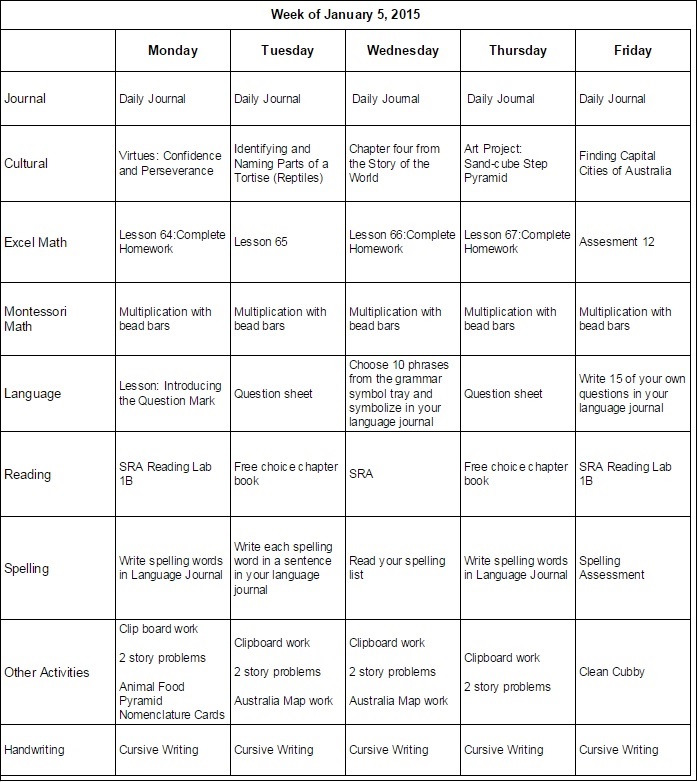In our Lower Elementary classroom, we utilize student work plans. These are individualized work assignments, given to each child each week. Several of the activities listed on the sheet are whole group lessons or cultural extensions, but the Montessori math and language activities are unique to each child.
Each child has a clipboard that is stored in his or her cubby area, with the work plan attached. The students carry their clipboards with them as they move throughout the room during the work cycle. At the end of each week, the work plan page is sent home so parents are able to see what their child has been doing throughout the week.
We have noticed that most children really enjoy “checking off” their work as it’s completed. (And there are some, too, that enjoy checking work off before it’s been completed. 😉 But that’s another story.)
We have gotten the children in the habit of showing written work down to a teacher once it’s complete, to make sure that it was done accurately and if any revisions need to be made. For work such as card sorts for cultural lessons, we do not require a teacher to review it – the children do a good job of self-checking, especially when they’re working in pairs.
As most classes go, there are some students who tend to be more responsible and independent, and who will go about their day without hesitation, easily moving from one activity to another. There are several of our younger first year students, though, who need a little more structure. If a child needs to be redirected, we often ask the child to bring us his or her clipboard and use that as a guide to ask which work they will be choosing. If he or she needs to be redirected multiple times, a child may lose the privilege of choosing work from the work plan and have a teacher choose what the next activity will be.
All in all, the student work plans seem to be a good method for giving the children a mental picture of what work needs to be accomplished over the course of the day and week and an easy tool to guide them to choose their next task.
Here is an example of what we use in our Lower Elementary room. These are created in Google spreadsheets. The student name is typically listed above the date, but I’ve omitted that here.
This seems to be a good system for our room. I’ve also used it successfully at another school in a Lower Elementary room. Student work plans are flexible and relatively easy to create and manage, which is always a bonus in our busy teacher days!


These look effective. Do you create the ‘type written’ plans for each child – as you include them in a consult? Is there any part that involves their own hand-writing? I am a new E1 guide, and will be having a young K-1 class…(5-6s) since we are transitioning to a new EL program. It would be good to know whether the young 1st graders really need help with a written work plan (as opposed to keeping track of their own ‘agenda’ and recording their work on a ‘blank’ work-journal page. I am having to assemble work journals of somekind this week, and like the idea of their doring as much writing as possible, while recording their work progress.
My name’s Mel I live and work in JHB,SA. I am an Upper Elementary Montessori , Directress. I,too have a similar planner but yours has inspired me to up my game. I think my kids do way too little in a day 🙂
Thank you for sharing
I love this idea! One question, are the students expected to complete all of the activities each day? If not, how do they know which ones need to be completed? Thank you!